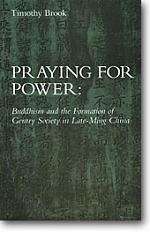Praying for Power
 Front cover of Praying for Power | |
| Author | Timothy Brook |
|---|---|
| Country | United States |
| Language | English |
| Genre | History |
| Publisher | Harvard University Asia Center[1] |
Publication date | February 1994 |
| Media type | Print (Hardback) |
| Pages | 412 pp. |
| ISBN | 0-674-69775-8 |
Praying for Power: Buddhism and the Formation of Gentry Society in Late-Ming China is a history book which explores the relationship between Buddhism and Neo-Confucianism during the 17th and 18th centuries in China (the late Ming Dynasty); tourism to Chinese Buddhist sites, and the patronage of Buddhist monasteries in China by Buddhist and Neo-Confucian gentry during this period.[2] This philanthropy allowed these patrons to "publicize [their] elite status outside the state realm" and promoted the growth of a society of gentry.[2]
The book is written by Timothy Brook, a distinguished[3] Canadian historian who specializes in the study of China (Sinology).[4]
Synopsis
Praying for Power is divided into three main sections:
In Part 1, "The Culture of Buddhism", Brook reviews the development of religious philosophy and politics and the new familiarity with, and openness toward, Buddhism, in what was a Confusianism-dominated society.[5]
In Part 2, "Monastic Patronage'", the author investigates the contributions of the new elite class of gentry, made in the form of "land donations; money and materials for building and renovation; exercise of social and political influence to forward and protect monastic interests; and 'literary patronage,' the composition of admiring poems and essays or the compilation and printing of an institutional history to elevate the prestige of a given monastery."[5]
In Part 3, "Patronage in Context", the author examines in detail patronage by the gentry in three distinct counties: one poor, "where Buddhist institutions were not well developed"; a second rich, where they flourished; and a third "in peculiar circumstances that allow Brook to highlight the ambiguous position of the county magistrate vis-à-vis[6] monastic patronage."[5]
Reception
Praying for Power is frequently cited in other scholarly works[7] and referred to in documents on the web sites of many educational establishments.[8]
Writing in the international journal of Sinology T'oung Pao, Barend J. ter Haar describes Praying for Power as a "splendid book".[9] He states that this "excellent introduction" is a "sound piece of investigative research" and that the author makes "important contributions" in two areas neglected in study in the West: the social history of Buddhism in late Ming China and social elites.[9]
In The American Historical Review, Lynn Struve writes that the author "makes a substantial contribution to our understanding of a lamentably neglected subject area: the place of Buddhism in late-Imperial Chinese culture and society."[5] She explains that "the core source material of this book is a large body of local and monastic histories, usually called 'gazetteers' (difang zhi and sizhi), and Brook masterfully shows what can be done through assiduous mining of this genre."[5] The reviewer does caution, however, that though the specialist will appreciate Part 3 of the book ("Patronage in Context"), the non-specialist will find it "heavy going".[5]
Foreign translations
- (Chinese) Nanjing: Jiangsu renmin chubanshe, 2004.
See also
Notes
- ↑ Timothy Brook (1993). Praying for Power: Buddhism and the Formation of Gentry Society in Late-Ming China. Harvard Univ Asia Center. ISBN 978-0-674-69775-1.
- 1 2 From the book's own product description. See Amazon Books page
- ↑ Dirda, Michael (27 January 2008). "Painting the World: How a hunger for tea and tobacco created global trade.". Washington Post. Retrieved 2010-01-22.
- ↑ Conrad, Peter (29 June 2008). "A time when every picture told a story". The Observer. Retrieved 2010-01-22.
- 1 2 3 4 5 6 Struve, Lynn (June 1995). "Praying for Power: Buddhism and the Formation of Gentry Society in Late- Ming China by Timothy Brook". The American Historical Review. American Historical Association. 100 (3): 930–931. JSTOR 2168690.
- ↑ vis-à-vis: "with regard to" or "in relation to".
- ↑ See Google Scholar search
- ↑ See Google web search on ".edu" web sites and ".ac.uk"
- 1 2 ter Haar, Barend J. (1999). "Praying for Power: Buddhism and the Formation of Gentry Society in Late-Ming China by Timothy Brook". T'oung Pao. BRILL. 85 (4/5): 515–520. doi:10.1163/1568532992642413. JSTOR 4528819.
References
- Barrett, T. H. (December 1994). "Praying for Power: Buddhism and the Formation of Gentry Society in Late-Ming China by Timothy Brook". International Journal of Asian Studies. Cambridge University Press. 140: 1151–1153. doi:10.1017/S0305741000053029. Retrieved 2010-01-26.
- Naquin, Susan (December 1995). "Praying for Power: Buddhism and The Formation of Gentry Society in Late-Ming China by Timothy Brook". Harvard Journal of Asiatic Studies. Harvard-Yenching Institute. 55 (2): 556–568. JSTOR 2719353.
- Struve, Lynn (June 1995). "Praying for Power: Buddhism and the Formation of Gentry Society in Late- Ming China by Timothy Brook". The American Historical Review. American Historical Association. 100 (3): 930–931. JSTOR 2168690.
- ter Haar, Barend J. (1999). "Praying for Power: Buddhism and the Formation of Gentry Society in Late-Ming China by Timothy Brook". T'oung Pao. BRILL. 85 (4/5): 515–520. doi:10.1163/1568532992642413. JSTOR 4528819.
External links
[view template]
- Academic profile at the Faculty of Oriental Studies, University of Oxford (2009)
- Author's pages at Beverley Slopen Literary Agency